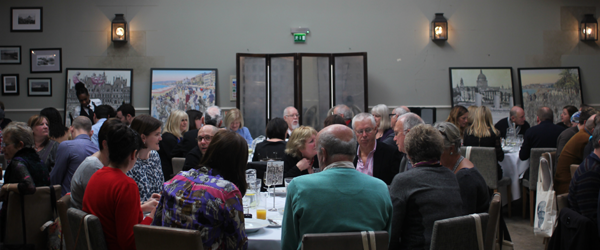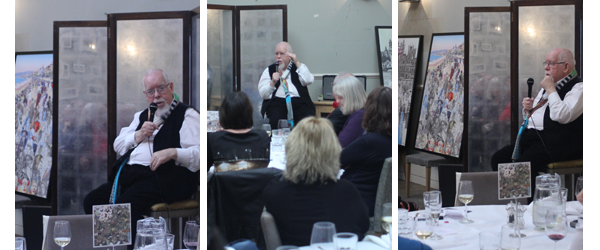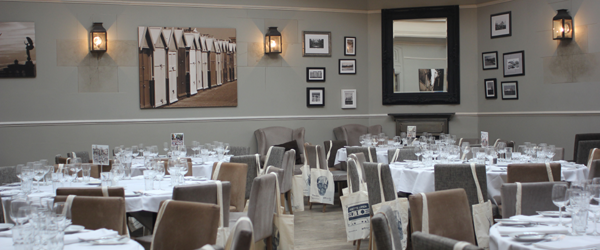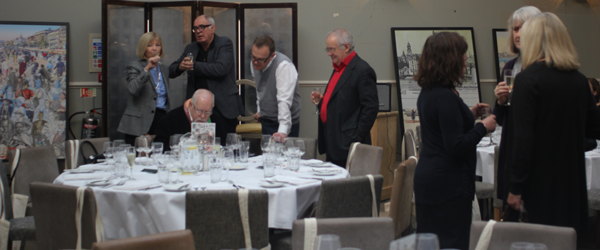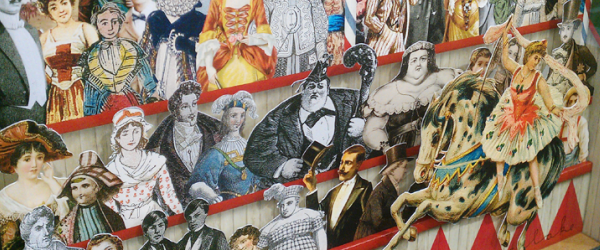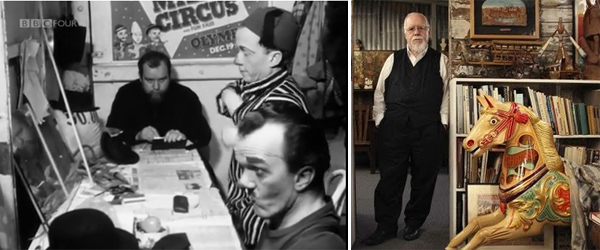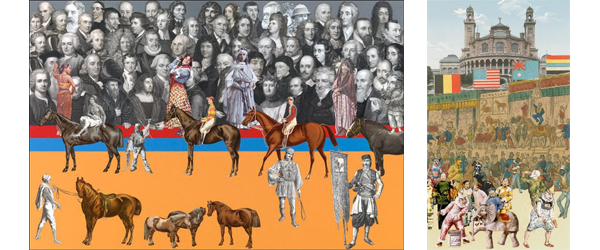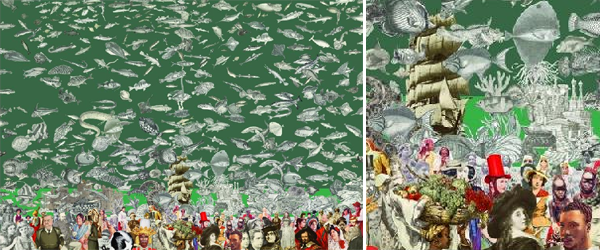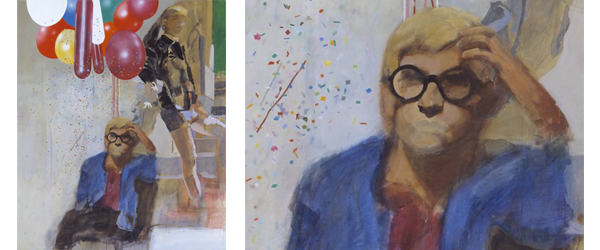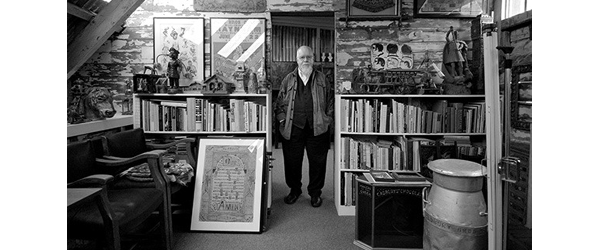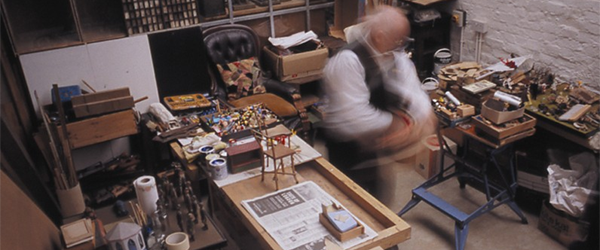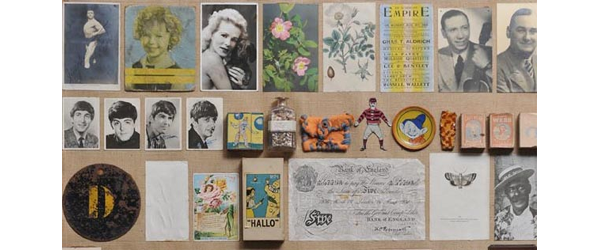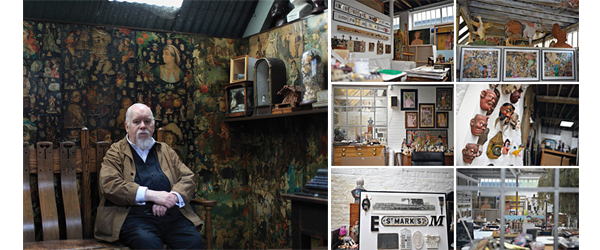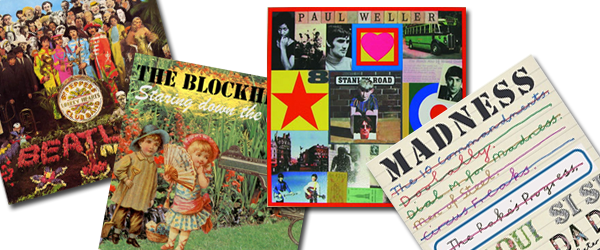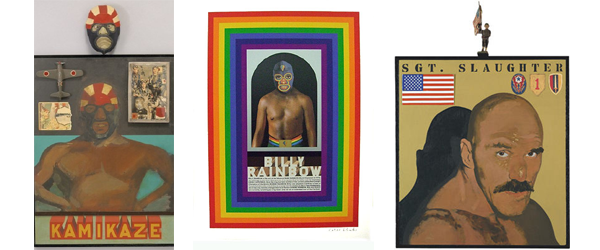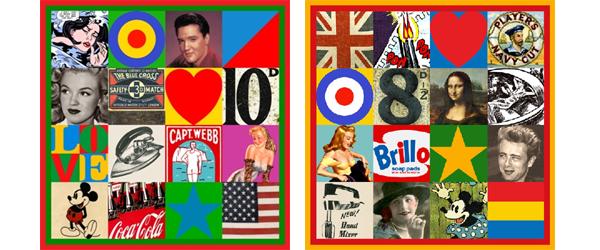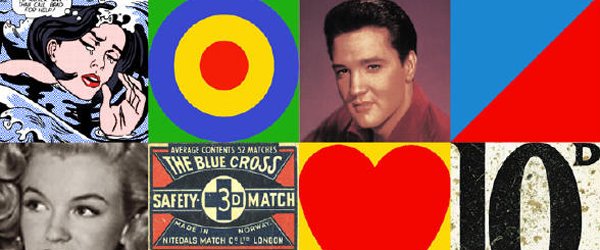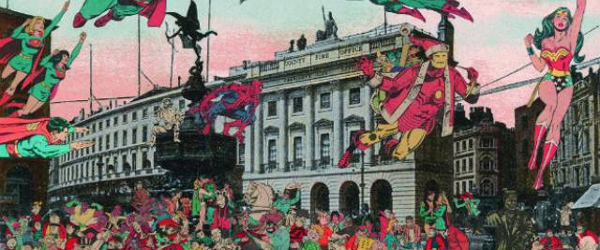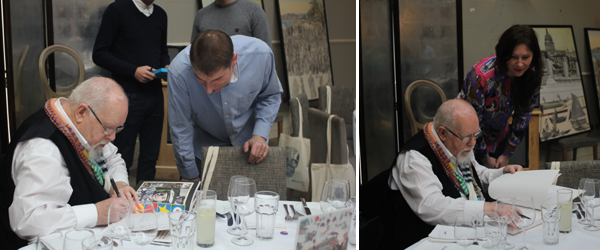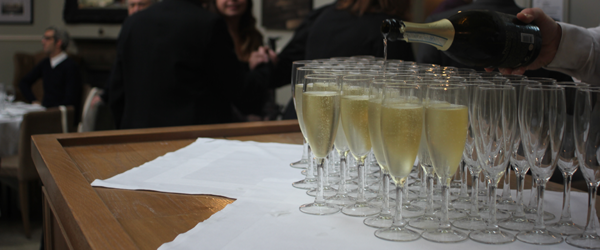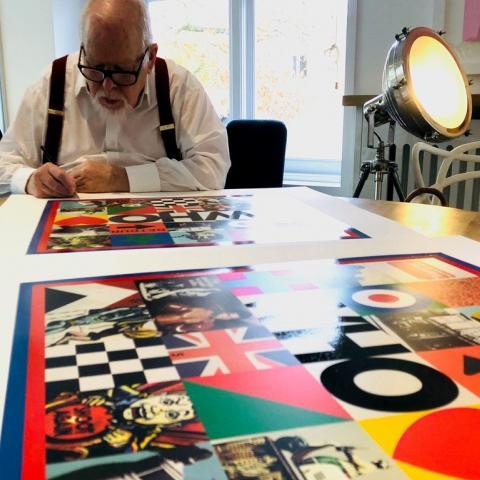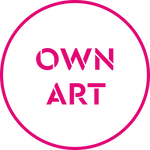Last weekend artrepublic held an exclusive lunch with Sir Peter Blake and a lucky host of guests. Following a champagne reception and scrumptious food at the Hotel du Vin, Brighton, we were treated to a lively and illuminating question and answer session with the legendary Godfather of British Pop Art.
Peter Blake generously spoke to the captivated audience about his love of the circus, his eclectic collection of ephemera, his dislike of Roy Lichtenstein and the time he turned down the MoMA. With questions on topics ranging from album art to British youth culture and the threat of technology, it was a fascinating insight into the artistic life and career of the grandee of British visual culture. Below are some of the highlights of Peter’s candid and humorous dialogue –
Peter Blake began by clarifying that he did not intend to spend the entire afternoon discussing the notorious Sgt. Pepper’s Lonely Hearts Club Band album cover, but it wasn’t long before the matter of the illustrious Beatles artwork was raised…
Artist Chemical X asked whether it was “good or bad being defined or known for one thing?”
After an amusing expletive, Peter’s repartee revealed his sharp wit. He told the audience “I’m proud to have done it”, despite the frustrating challenge of his gallery at the time signing away the copyright. Peter doesn’t have an ‘original’ of the iconic Beatles cover because the image was an intricate real-life stage set made from life-size cut-outs, wax work models and textile creations. As a result Peter has been represented by a QC working for DACS (Design and Artists Copyright Society) attempting to get just financial recognition for the work (he was paid just £200 at the time).
Peter suggested that he has accepted and moved on from the Sgt. Pepper matter, “I’m not defined by it anymore.” He pointed to the resurgence of interest in Pop Art and his recent high profile projects helping the epochal album cover to “take its place in the order of things.” Projects such as Peter’s current acclaimed exhibition at the National Museum Cardiff, ‘Llareggub: Peter Blake Illustrates Dylan Thomas’s Under Milk Wood’.
Peter’s pioneering Pop Art paintings were considered shocking and controversial by many at the time (the Swinging Sixties), can art still be shocking?
“I don’t think I ever used shock tactics. I didn’t want to shock”, clarified Peter. He believes that it was the subject matter that was shocking at the time; his interest in wrestlers, popular icons and circuses. On the question of whether it is still possible to shock with art today, Peter replied with admirable conviction, “I’m sure you still could if you wanted to. I wouldn’t do it.”
Where did his interest in the circus and fairground originate from?
The circus has long been a source of inspiration for Peter. Motifs from the fairground and the circus can be found throughout his oeuvre, from very early figurative works to recent projects such as his three dimensional Circus Collage triptych. Peter earnestly explained that it is “a class thing”. He believes that he inherited his fascination with the popular entertainment extravaganzas from his working class parents.
Thinking more about the circus as a source of inspiration he said “the glamour; that I enjoy” and “how I explain why I like it is difficult.” It certainly became clear that Peter is a true connoisseur of the circus. Like many of his fascinations he has intently submersed himself in the colourful world, passionately reeling off his favourite clowns and describing the sights of the circus in Paris in 1956.
“Ken Russell filmed a lot at the circus,” Peter told the audience. Ken Russell’s cutting edge documentary ‘Pop Goes the Easel’ is a beautiful portrait of a 29-year-old Peter. It records the many hours Peter spent sketching clowns and drawing behind the scenes of Sixties circuses.
How long does it take to create a suite? How do you explain your incredible work rate?
Peter’s output has been prolific, much to the appreciation and enjoyment of our audience of collectors. His work rate is remarkable and incredibly inspiring. He explained that many works and projects overlap and the time it takes to create them varies considerably. His 2009 limited edition print ‘Aquarium’ took months of evenings of cutting out collaged elements and 2 weeks’ worth of sticking swarming fish.
There has been much publicity about his Dylan Thomas exhibition, the culmination of 28 years worth of infatuation and loving study of ‘Under Milk Wood’, but Peter also mentioned his portrait of fellow Pop Art figure and long-time friend David Hockney as an example of one of his more lengthy creations. He started the portrait of fellow Royal College of Art alumnus David Hockney in the 1960s and it was finally presented over thirty years later to the Tate in 2002. Peter went on to list an overwhelming number of projects that he’s currently focusing on finishing.
He reassured the astonished audience (feeling somewhat inadequate by this point), “I’m not working constantly”. His studio is separate from his house. He gets the bus to the studio and usually works 11-6. This work rate alone is remarkable but Peter went on to admit that he usually works on something at home too! “It’s just a pleasure, I just love doing it” he told us.
He described working at home watching TV with his wife Chrissy. With the TV on in the background, he is able to watch the replays of the goals he misses whilst he’s drawing, collaging and painting. Peter is big Chelsea football fan; he even created a 3ft collage for the club titled ‘Made from 100% Chelsea’.
Peter is a renowned collector of ephemera, what one piece would he save from a fire?
This was a difficult question for Peter who is famous for his collections of found objects and ephemera. Although his collections were never created for public display, just for his own pleasure, a significant proportion of them went on display at the Museum of Everything in a show he co-curated with James Brett in 2010.
“I keep special things in the studio”, Peter explained, listing music memorabilia, Victoria taxidermy, folk art, theatrical curios and vintage toys amongst his expansive and eclectic compilations. He revealed that his favourite are a hat worn by Douglas Fairbanks Jr., shoes worn by the famous Victorian dwarf General Tom Thumb and a stick and a pair of clown shoes once belonging to Max Miller. Staying true to his preservation of popular culture, he finally picked the Max Miller shoes to save from the hypothetical fire.
Throughout his career, Peter has worked with numerous preeminent musicians, designing album covers for the likes of The Beatles, The Who, Ian Dury, Eric Clapton, Paul Weller, Oasis and Madness. Does he think that the demise of the LP will be the death of music art?
Peter proclaimed that “the LP is coming back” and “luckily everything I’ve done has come out as an LP as well”. Thankfully, despite the vast changes that have occurred in the music industry in the decades Peter has been working, he explained that he still does exactly the same for contemporary musicians as he did for the Sixties bands. The only difference now is that he uses the computer. Actually, “I can’t use a computer,” he confessed, but someone in the studio assists him with translating his album designs, such as the recent Madness release, onto the computer.
Peter has embraced new technology with an unusual enthusiasm and youthful vigour; he often speaks about his work exploring cutting-edge printing techniques such as 3D lenticular printing. Is he concerned about the impact of technological advances on the next generation of artists?
In short, “Yes”. Peter and his wife and Chrissy recently visited an art college and Peter was shocked to find that almost every student there was working on a computer. He firmly asserted to the audience, “it should be used as a tool… If everything was done on the computer it would be a bad thing.” But he accepted that modern technology is a “wonderful tool”. He also said that “I’m not the person to ask”, suggesting that this was really a matter for young artists at the beginning of their careers to address.
Over the decades Peter’s Pop Art has moved from figurative oil painting, to intricate collages and bold graphic pieces, has he drifted into different styles and mediums?
Peter answered this question with a beautiful metaphor. He described his career as a tree. The trunk and roots are his figurative painting and the branches represent his experiments with different techniques and directions. The image wonderfully describes his enthusiasm for experimentation and his terrific accomplishments in numerous mediums, but also his unwavering commitment to figurative painting, as seen in the exhibition ‘Llareggub: Peter Blake Illustrates Dylan Thomas’s Under Milk Wood’.
Peter explained how he was actually advised to become a graphic designer and described himself as a “rogue graphic designer and a rogue painter.” There a crossovers and interchanges between the different disciplines through his artwork. Thinking about his numerous series and collections his fascination with graphics, typeface and text has been a lasting theme.
What would Peter Blake have been if not an artist?
“Probably an electrician”. Peter’s first art school was part of the technical school and he very nearly studied for a trade until he realised he could do fine art instead, “art was a gift”. “I would have liked to work in wood as some sort of craftsman,” Peter explained. Although, he admitted when asked this question by the Sunday Times Magazine he replied “professional wrestler” in a rogue attempt to make the article more interesting! Of course, professional wrestlers are another fascination of Peter’s but he doubts that he would have made a great wrestler himself!
Peter is described as the Godfather of British Pop Art, but which Pop artists have inspired him?
“Rauschenberg, Jasper Johns, Stanley Spencer, Paul Klee, Joseph Cornell, Kurt Schwitters,” listed Peter, amongst a stream of other artists. “Not Andy Warhol”, he professed. And “I never liked Lichtenstein, I thought he was patronizing about comic books,” a popular subject matter that Peter has taken seriously throughout his career, “I use comic book imagery a lot” (a fine example is ‘London - Piccadilly Circus - The Convention of Comic Book Characters’).
Peter has collaborated with numerous musicians and artists through his career and painted countless portraits of diverse subjects, but has he ever refused any commissions for moral or political reasons?
“I’ve shot myself in the foot 3 times,” Peter confessed to the enthralled audience. His first show in New York in 1961 received terrible criticism from the New York critics and consequently Peter “vowed never to show in New York. It wasn’t a wise move”. Bravely turning down the MoMA’s offer of a show was “a mistake probably,” Peter admitted in his characteristically modest style.
Peter’s second refusal came when he “told the gallery don’t ever sell my work to Saatchi,” believing that “Saatchi will always be a dealer, not a collector.” That “might have been a mistake too,” Peter said smiling at the chuckling guests. His last big veto was a proposed portrait commission from a high-powered and renowned arms dealer. The man had previously paid Lucian Freud £1mil to paint his portrait and invited Peter to drinks hoping to employ him to create a new work. Peter questioned whether it was the best decision to walk away from such a potentially sizable cheque but he proudly declared, “I turned down a lot over the years, I’ve been pretty moral really.”
A moral, wise and witty artist; lunch with Peter Blake was a true treat! The audience and artrepublic were delighted to be in the presence of the Pop Art legend who generously spoke so openly about his career and thoughts on the art world. Our thanks go to Peter for his wonderful visit and fascinating words. Here’s a toast to one of Britain’s finest cultural luminaries.

